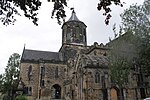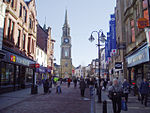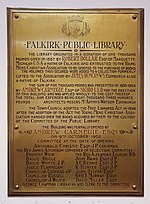Falkirk Steeple
1814 establishments in ScotlandBuildings and structures in FalkirkCategory A listed buildings in Falkirk (council area)Clock towers in the United KingdomListed government buildings in Scotland ... and 1 more
Towers completed in 1814

The Falkirk Steeple is a landmark which dominates the skyline of Falkirk in central Scotland. The present structure on the High Street was built in 1814, and replaced an earlier steeple dating from the late 17th century, which itself replaced a still earlier structure. The Falkirk Steeple is protected as a category A listed building. A stylised image of the steeple appears on the crest of Falkirk Football Club.
Excerpt from the Wikipedia article Falkirk Steeple (License: CC BY-SA 3.0, Authors, Images).Falkirk Steeple
Lint Riggs,
Geographical coordinates (GPS) Address Nearby Places Show on map
Geographical coordinates (GPS)
| Latitude | Longitude |
|---|---|
| N 55.999 ° | E -3.785 ° |
Address
Howgate Shopping Centre
Lint Riggs
FK1 1EU , Grahamston
Scotland, United Kingdom
Open on Google Maps









